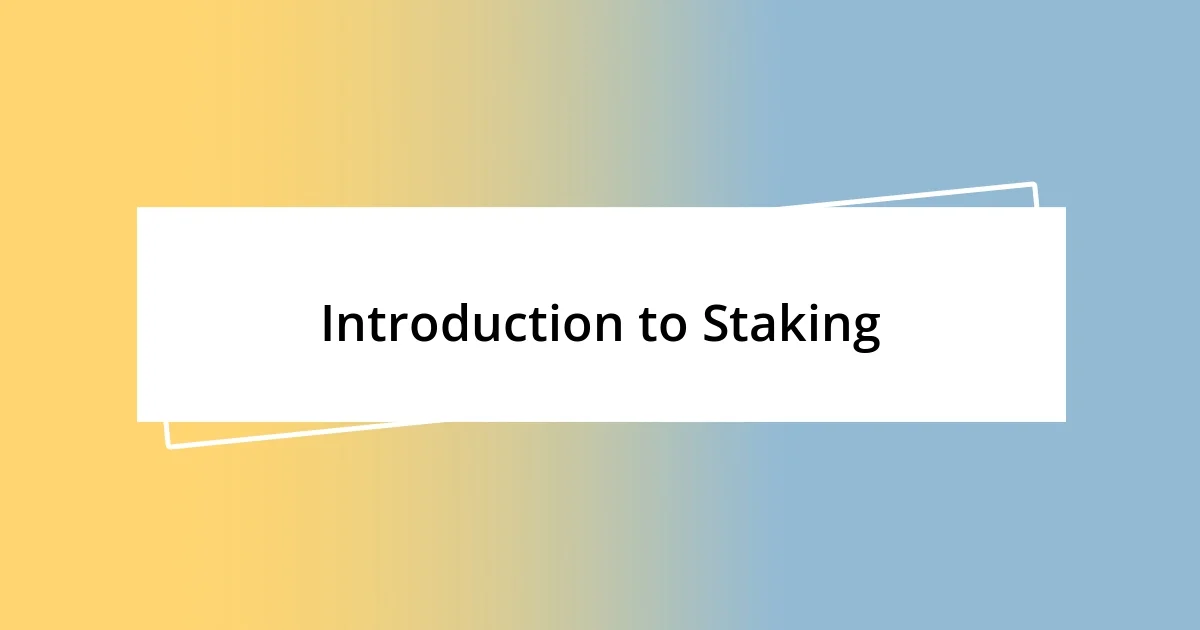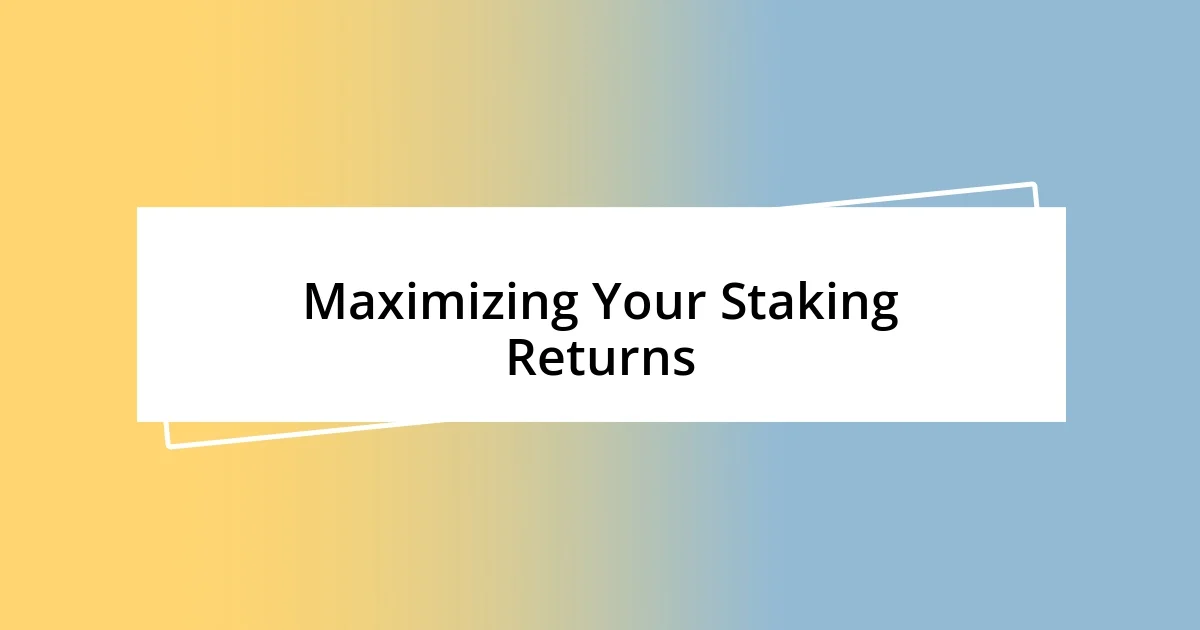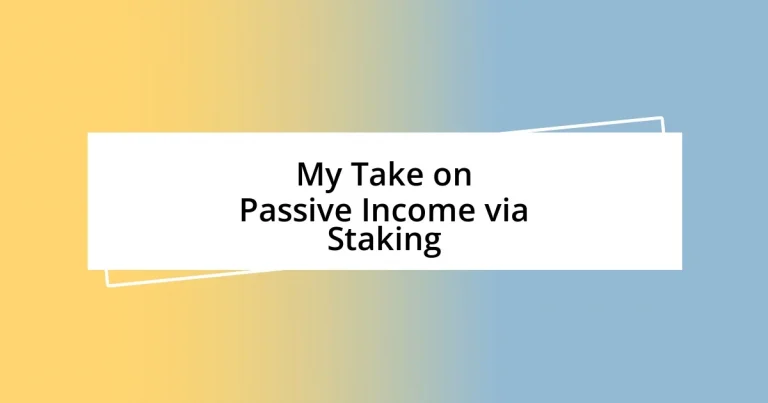Key takeaways:
- Passive income requires initial effort and planning; it’s not just about doing nothing.
- Staking provides a low-effort avenue for earning rewards while contributing to blockchain security.
- Understanding risks, choosing the right platform, and community engagement are essential for maximizing staking returns.

Understanding Passive Income
Passive income is essentially money that flows in without requiring constant effort. I remember the first time I received a royalty payment for a piece of writing – it felt like magic. Seeing funds land in my account while I was busy with other projects made me realize the power of creating income streams that work for you, rather than you working for them.
Many people think passive income means sitting back and doing nothing, but that’s a misconception. In my experience, it often takes a good amount of initial effort and investment. For instance, I once spent months researching and setting up an online course. The moment it launched, and sales trickled in, I understood the beauty of creating something that can generate revenue over time with little ongoing effort.
Engaging in ventures that produce passive income can feel incredibly rewarding, but it’s important to maintain realistic expectations. Have you ever imagined how it would feel to wake up to find you’ve earned money while you slept? I can tell you, it’s exhilarating! Just remember, the journey to passive income is a marathon, not a sprint—one that requires patience and thoughtful planning.

Introduction to Staking
Staking is an intriguing concept that draws on the principles of blockchain technology. Simply put, it involves locking up cryptocurrency in a wallet to support the operations of a blockchain network. When I first got into staking, I was struck by how it felt like a collaborative venture—you’re contributing to the network’s security while earning rewards in return. It’s like being part of a team with shared goals.
What captivated me about staking is its simplicity. Unlike trading, which demands constant monitoring and quick decisions, staking allows for a more laid-back approach. I can recall my weekend evenings spent reading a book while my staking rewards accumulated quietly in the background. It’s a nice feeling knowing that your investment is not just sitting there idly, but actively working for you.
Moreover, the potential returns can be quite appealing. Staking typically offers better yields than traditional savings accounts, which is especially exciting in a world where interest rates often leave much to be desired. It made me wonder—how could you not explore this opportunity? The blend of passive earnings and cryptocurrency’s dynamic nature captures both excitement and peace of mind.
| Aspect | Staking |
|---|---|
| Involvement | Low (once set up) |
| Rewards | Often higher than traditional savings |
| Risks | Market fluctuations and protocol risks |
| Time Commitment | Minimal ongoing effort |

Benefits of Staking Assets
The benefits of staking assets are truly noteworthy. Personally, I’ve found that staking not only generates passive income but also enables me to participate actively in the blockchain ecosystem. It’s a fulfilling feeling knowing my assets are working toward network security, which contributes to the overall health of the cryptocurrency community. Each time I check my rewards, it feels like a little victory, reinforcing my investment decision.
Here’s a brief overview of the advantages staking can offer:
- Passive Income Generation: Earn rewards without active trading.
- Lower Risk Compared to Trading: Markets don’t need constant monitoring.
- Community Contribution: Play a vital role in network security and performance.
- Flexible Liquidity Options: Depending on the platform, withdraw or re-stake easily.
In my experience, the combination of financial growth and community engagement has made staking an attractive choice. Watching my staked assets grow over time brings a sense of accomplishment, much like tending to a garden—every bit nurtured yields a rewarding harvest. It’s comforting to know that, unlike some investments, my assets are not just stagnant; they’re engaged and actively earning.

Choosing the Right Platform
When it comes to choosing the right platform for staking, it’s crucial to consider the user experience. I remember my first foray into staking—confusing interfaces and complicated processes made it more frustrating than rewarding. A platform should feel intuitive and provide clear guidance on how to stake your assets effectively. If you find yourself scratching your head at every turn, it might be wise to look elsewhere.
Another important factor to weigh is the fees associated with staking. Some platforms charge significant withdrawal fees or take a cut of your rewards. For instance, I was initially lured in by a flashy platform promising high returns, only to find unexpected fees eating into my profits. Always read the fine print; those fees can chip away at your earnings without you even realizing it.
Lastly, consider the security measures a platform has in place. Given the volatility of the cryptocurrency space, security should be a non-negotiable aspect of your decision-making. I’ve heard of too many horror stories where users lost their staked assets due to poor security practices. Trust me, investing in a platform that prioritizes your assets’ safety not only provides peace of mind but also enhances your overall experience with staking.

Steps to Start Staking
To begin staking, the first step is selecting a cryptocurrency that supports it. I’ve always found that not all cryptocurrencies offer staking, so doing a bit of research is essential. For my first staking experience, I focused on a coin that had a solid community and good long-term potential, which served me well.
Once you’ve chosen a cryptocurrency, setting up a wallet to hold your assets is the next move. I vividly remember the sense of accomplishment when I finally set up my wallet correctly, but I also felt a tinge of anxiety—what if I made a mistake? Your wallet is crucial for receiving rewards and managing your staked assets, so taking time to understand wallet types, like hot wallets for quick access or cold wallets for security, can pay off nicely.
After securing your wallet, it’s time to choose a staking platform. I often like to check reviews and user experiences before committing. I still recall logging into my first staking platform; the excitement was palpable, but so was the nervousness. Would this be easy and worthwhile? Make sure the platform aligns with your needs in terms of fees, rewards, and user-friendliness, because the right choice can turn staking into a truly enjoyable experience.

Common Risks of Staking
When diving into the world of staking, it’s essential to recognize that nothing is risk-free. I remember the time I staked some assets only to experience unforeseen slumps in prices due to market fluctuations. It was a hard lesson: while staking can generate passive income, the value of your investment can still drop, leaving you to wonder if the rewards are worth the risk.
Another significant risk involves the concept of slashing, where your staked assets might be partially forfeited as a penalty for network misbehavior or security breaches. This was something I didn’t fully grasp at first. Hearing tales of others losing a portion of their stake made me keenly aware of the importance of participating in well-established networks with a solid track record.
Lastly, I can’t help but emphasize the importance of liquidity. Staking typically locks up your assets for a certain period, which can be unsettling. I vividly recall feeling anxious about my own staked coins when an unexpected expense popped up; I wished I could access those funds immediately. Understanding the limits on withdrawals is vital because it can shape your financial planning significantly. Have you ever felt linearly tied down by an investment? It’s something that requires careful consideration when staking.

Maximizing Your Staking Returns
To truly maximize your staking returns, it’s crucial to stay informed about the coins you hold and their ongoing performance. I remember a period when I neglected to track the staking updates for one of my assets, and it cost me. Missing out on potential network upgrades or changes in staking rewards left me wondering how much more I could have earned.
Another tactic that worked for me was diversifying my staking portfolio. Instead of putting all my eggs in one basket, I chose to stake different cryptocurrencies. This strategy not only broadened my earning potential but also eased my anxiety during market volatility. Have you ever considered that spreading your investments could help mitigate risks while optimizing returns? It can shift your overall experience from merely surviving to thriving in the staking space.
Lastly, engaging with the community can provide valuable insights and tips. I fondly recall joining forums and social media groups where fellow stakers shared their strategies and recent experiences. Connecting with others brought a sense of camaraderie and allowed me to learn from their challenges and successes. It’s amazing how much wisdom is shared in these spaces—have you tapped into this resource yet? Even a single tip from a seasoned staker can vastly alter your approach to maximizing returns.














